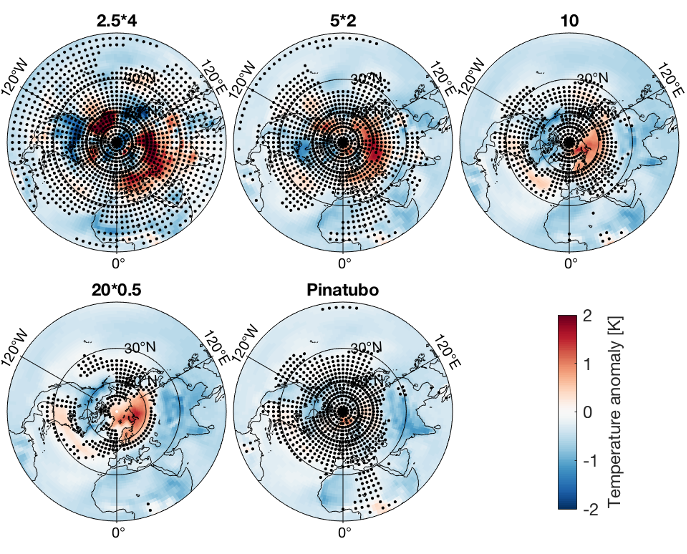The Arctic polar vortex response to volcanic forcing of different strengths
In a new study, Alon Azoulay, Hauke Schmidt, and Claudia Timmreck from the department “The Atmosphere in the Earth System” at the Max Planck Institute for Meteorology (MPI-M) analyze large ensemble simulations with the MPI Earth System Model (MPI-ESM) to show that the circulation response depends nonlinearly on the amount of sulfur injected into the stratosphere (Fig. 1).


To answer this question Azoulay et al. performed large (100-member) ensemble simulations of the climate response to idealized volcanic aerosol distributions for tropical eruptions with stratospheric sulfur injections from 2.5 to 20 Tg. For comparison, the Pinatubo injection is assumed to have been of slightly less than 10 Tg(S). The simulations indicate the existence of a threshold somewhere between 2.5 and 5 Tg(S) below which the vortex does not show a detectable response. This nonlinearity is introduced partly through the infrared aerosol optical density which, due to increasing particle size, increases much stronger than linear with increasing injection amount. Additionally, the dynamical mechanism causing the vortex strengthening, which involves wave-mean flow interaction, seems not to set in for small aerosol loading.
Earlier studies have argued that stratospheric Arctic polar vortex anomalies can influence surface weather through dynamical downward coupling. More specifically, anomalously warm winters in Northern Eurasia, as observed after the Pinatubo eruption, have been linked to polar vortex strengthening induced by volcanic aerosol. A recent publication by Polvani et al. (2019), however, questioned this, arguing that the internal variability at this time and region is too large for an individual event to be attributed to a volcanic eruption. and showed that in ensemble simulations with three comprehensive climate models the mean winter post-Pinatubo temperature anomaly spatially averaged over 40–70°N and 0–210°E is indistinguishable from zero. Azoulay et al. confirm this for the simulation of the Pinatubo eruption with the MPI-ESM using a satellite-derived volcanic aerosol distribution, but show that the same model produces a statistically significant winter warming pattern for idealized aerosol distributions resulting from an injection amount similar to that assumed for the Pinatubo eruption (Fig. 2). In both cases, however, polar vortex strengthenings are simulated. This suggests that differences in the aerosol distribution may lead to different downward propagation of the polar vortex signals. More research is needed to understand this new puzzle.
Original publication:
Azoulay, A., Schmidt, H. & Timmreck, C. (in press) The Arctic polar vortex response to volcanic forcing of different strengths. Journal of Geophysical Research: Atmospheres, acc. article online: e2020JD034450. doi:10.1029/2020JD034450
References:
Bittner, M., Schmidt, H., Timmreck, C., & Sienz, F. (2016) Using a large ensemble of simulations to assess the Northern Hemisphere stratospheric dynamical response to tropical volcanic eruptions and its uncertainty. Geophysical Research Letters, 43(17), 9324-9332.
Polvani, L. M., Banerjee, A., & Schmidt, A. (2019) Northern Hemisphere continental winter warming following the 1991 Mt. Pinatubo eruption: reconciling models and observations. Atmospheric Chemistry and Physics, 19(9), 6351-6366.
Contact:
Dr. Hauke Schmidt
Max Planck Institute for Meteorology
Phone.: 040 41173 405
Email: hauke.schmidt@mpimet.mpg.de
Dr. Claudia Timmreck
Max Planck Institute for Meteorology
Phone: 040 41173 384
Email: claudia.timmreck@mpimet.mpg.de
